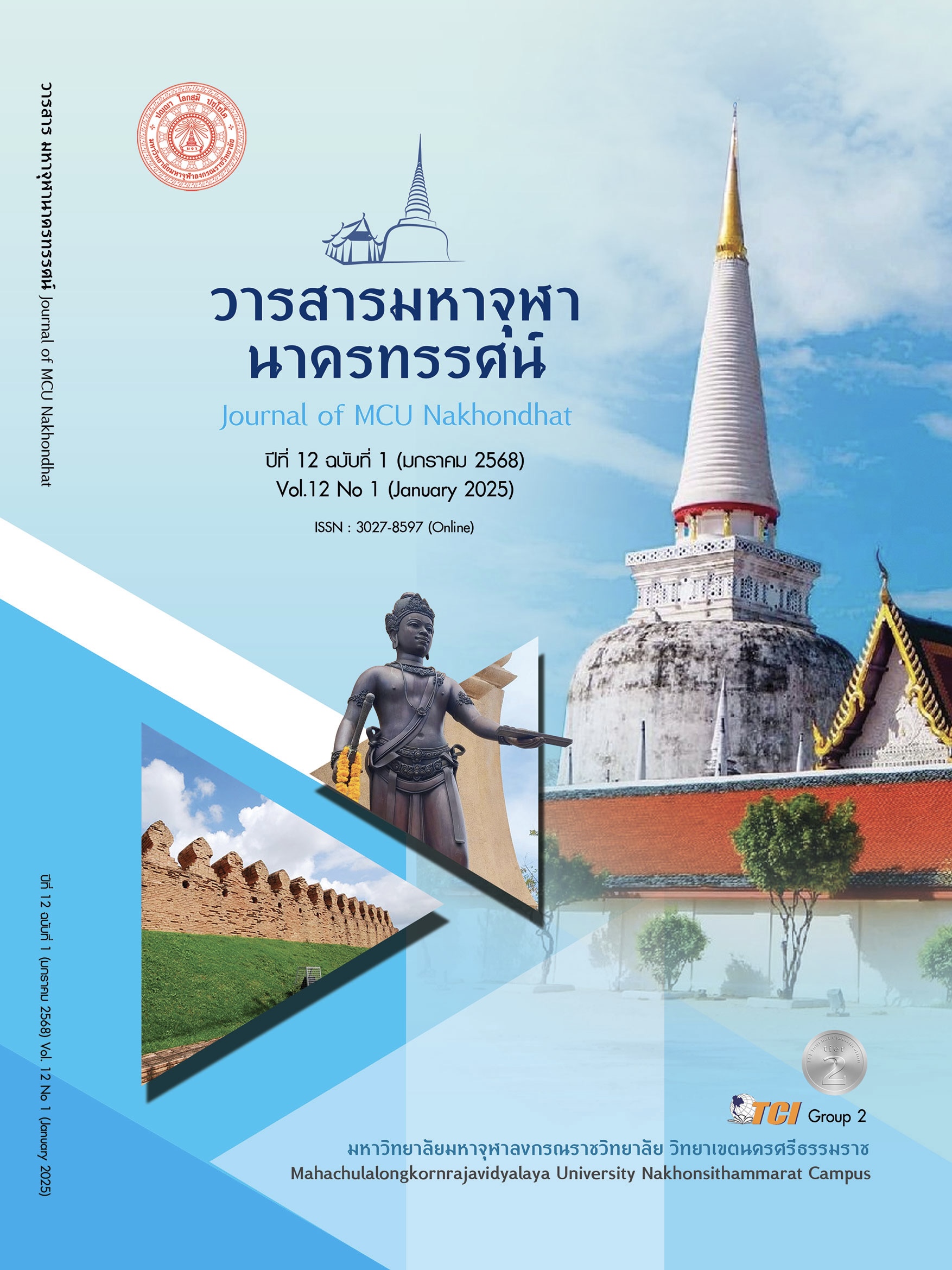THE ENHANCEMENT OF EMPATHY AMONG UPPER PRIMARY SCHOOL STUDENTS THROUGH GUIDANCE ACTIVITIES
Main Article Content
Abstract
This research aimed to 1) Compare the empathy levels of upper primary school students before and after participating in guidance activities and 2) Compare the empathy levels of upper primary school students between an experimental group participating in the guidance activities and a control group. The study employed a quasi-experimental design, with a research sample of Grade 6 students from a private school during the first semester of the 2024 academic year. The selection criteria were: students must have empathy scores at or below the 50th percentile, students must voluntarily agree to participate in the experiment, and students must have obtained parental consent. Twenty students were selected and randomly assigned into two groups: 10 for the experimental group and 10 for the control group. The research instruments included an empathy measurement scale for upper primary students, with a reliability coefficient of .90 and a set of guidance activities designed to enhance empathy, with an instrument quality value of 1.00. Statistical analyses utilize mean scores, standard deviations, and t-tests for dependent and independent samples. The findings revealed that 1) The students' post-test empathy scores significantly increased at the .05 level after participating in the guidance activities, and 2) The experimental group demonstrated significantly higher empathy scores than the control group at the .05 level.
Article Details

This work is licensed under a Creative Commons Attribution-NonCommercial-NoDerivatives 4.0 International License.
References
กรมสนับสนุนบริการสุขภาพ. (2566). กรม สบส. เผยผลสำรวจเด็กและเยาวชนเคยถูกบูลลี่ร้อยละ 44.2 ชวนยุว อสม. แกนนำนักเรียนร่วมกันเฝ้าระวังการบูลลี่ในระดับพื้นที่. เรียกใช้เมื่อ 3 ธันวาคม 2567 จาก https://hss.moph.go.th/show_topic.php?id=5747
กระทรวงศึกษาธิการ. (2560). แผนการศึกษาแห่งชาติ พ.ศ. 2560 - 2579. กรุงเทพมหานคร: บริษัทพริกหวานกราฟฟิค จำกัด.
กฤตวรรณ คำสม. (2559). บริการแนะแนวในโรงเรียน: ความสำคัญและความจำเป็น. กรุงเทพมหานคร: สำนักพิมพ์มหาวิทยาลัยธรรมศาสตร์.
วิจารณ์ พานิช. (2556). การสร้างการเรียนรู้สู่ศตวรรษที่ 21. กรุงเทพมหานคร: มูลนิธิสยามกัมมาจล.
วิเชียร เกตุสิงห์. (2538). ค่าเฉลี่ยกับการแปลความหมาย: เรื่องง่าย ๆ ที่บางครั้งก็พลาดได้. วารสารข่าวสารการวิจัยการศึกษา, 18(3), 8-10.
สมาคมแนะแนวแห่งประเทศไทย. (2559). เทคนิคการแสดงบทบาทสมมติในกิจกรรมแนะแนว. กรุงเทพมหานคร: สมาคมแนะแนวแห่งประเทศไทย.
สำนักงานคณะกรรมการการศึกษาขั้นพื้นฐาน. (2559). การจัดการเรียนรู้กิจกรรมแนะแนว. กรุงเทพมหานคร: โรงพิมพ์ชุมนุมสหกรณ์การเกษตรแห่งประเทศไทย จำกัด.
สำนักงานเลขาธิการสภาการศึกษา. (2556). แนวทางการแก้ปัญหาความรุนแรงในสถานศึกษา. กรุงเทพมหานคร: บริษัทพริกหวานกราฟฟิค จำกัด.
อาดัม นีละไพจิตร. (2557). การพัฒนาทักษะทางสังคมในวัยเด็กตอนปลาย. กรุงเทพมหานคร: สำนักพิมพ์แห่งจุฬาลงกรณ์มหาวิทยาลัย.
Bandura, A. (1986). Social foundations of thought and action: A social cognitive theory. USA: Prentice-Hall.
Cotton, K. (1992). Developing empathy in children and youth. School Improvement Research, 7(1), 25-40.
Damon, W. (2004). What is positive youth development?. The ANNALS of The American Academy of Political and Social Science, 591(1), 13-24.
Davis, M. H. (1983). Measuring individual differences in empathy: Evidence for a multidimensional approach. Journal of Personality and Social Psychology, 44(1), 113-126.
Eisenberg, N. (2006). Empathy-related responding and prosocial behavior. Novartis Foundation Symposium, 278(1), 71-80.
Erikson, E. H. (1959). Identity and the Life Cycle. New York: International Universities Press.
Goleman, D. (2020). Emotional intelligence: Why it can matter more than IQ. (25th ed.). London: Bloomsbury Publishing Plc.
Greenberg, M. T. et al. (2003). Enhancing school-based prevention and youth development through coordinated social, emotional, and academic learning. American Psychologist, 58(6-7), 466-474.
Hikmat, R. et al. (2024). Empathy’s Crucial Role: Unraveling Impact on Students Bullying Behavior-A Scoping Review. Journal of Multidisciplinary Healthcare, 17(1), 3483-3495.
Likert, R. (1967). The Method of Constructing and Attitude Scale, in Attitude Theory and Measurement. New York: Wiley & Son.
Lohr, S. L. (2019). Sampling: Design and analysis. (2nd ed.). Boca Raton: CRC Press Taylor & Francis Group.
Oberle, E. & Schonert-Reichl, K. A. (2017). Social and emotional learning: recent research and practical strategies for promoting children’s social and emotional competence in schools. New York: Springer International Publishing AG.
Scott, K. E. & Graham, J. A. (2015). Service-learning: Implications for empathy and community engagement in elementary school children. Journal of Experiential Education, 38(4), 354-372.
Seligman, M. E. & Csikszentmihalyi, M. (2000). Positive psychology: An introduction. American Psychological Association, 55(1), 5-14.
Thai Life Channel. (2014). Thai life insurance: unsung hero. Retrieved July 30, 2024, from https://www.youtube.com/watch?v=oujqv98ZsZM
Vivvi. (2022). Direct guidance vs. indirect guidance examples. Retrieved November 8, 2024, from https://vivvi.com/blog/articles/indirect-vs-direct-guidance-examples
Vygotsky, L. S. (1978). Mind in society: The development of higher psychological processes. Massachusetts: Harvard University Press.
World Health Organization. (1997). Life skills education for children and adolescents in schools. Retrieved December 15, 2023, from https://iris.who.int/bitstream/handle/10665/63552/WHO_MNH_PSF_93.7A_Rev.2.pdf?sequence=1&isAllowed=y


